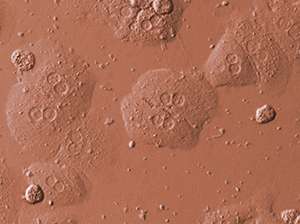HEXIM1 regulatory protein induces human pluripotent stem cells to adopt more specialized cell fate

A lot of optimism and promise surrounds the use of human pluripotent stem cells (hPSCs) for applications in regenerative medicine and drug discovery. However, technical challenges still hamper the culturing and differentiation of these cells, which include the cell types known as human embryonic stem cells (hESCs) and their reprogrammed equivalents, induced pluripotent stem cells (iPSCs).
A team of A*STAR scientists has now discovered a regulatory protein that helps to coax human pluripotent stem cells to form more specialized types of cells. "Our finding could help to develop a new protocol to induce differentiation of human pluripotent stem cells," says Sheng-Hao Chao from the A*STAR Bioprocessing Technology Institute (BTI) in Singapore, who led the study.
Chao and his co-workers at the BTI's Expression Engineering Group have been studying a protein called hexamethylene bisacetamide-inducible protein 1 (HEXIM1) for many years. HEXIM1 is known to inhibit a protein complex called positive transcription elongation factor b (P-TEFb), which is involved in gene expression. Chao's team previously linked HEXIM1 with a specific pathway involved in cancer development. This led the researchers to suspect an additional role for HEXIM1 in regulating stem cells.
Chao's group teamed up with Andre Choo and his colleagues in the Stem Cell Group at the BTI to further explore this possibility. They first treated hESCs with a differentiation-inducing compound called LY294002 and saw a marked increase in HEXIM1 levels compared to untreated cells.
Further tests showed that HEXIM1 played a role in driving cellular differentiation. For example, the hESCs differentiated when the researchers incubated the cells with hexamethylene bisacetamide (HMBA), a HEXIM1 inducing reagent, or when they generated and cultured a cell line with elevated expression of HEXIM1. The researchers rule out P-TEFb inhibition as an explanation for the effect, however, because in another experiment, hESCs treated with flavopiridol—a drug that blocks P-TEFb activity—remained in a pluripotent state.
"We discovered a novel function of HEXIM1 in regulating the early-stage differentiation of human pluripotent stem cells through a P-TEFb-independent pathway," says Chao. More work is still needed to investigate in detail the molecular mechanism by which HEXIM1 drives hPSC differentiation.
Eventually, HEXIM1 could become a useful tool in generating new tissues for cell-replacement therapies. "In combination with other transcription factors or chemicals, it is possible that HEXIM1 and its inducing reagent HMBA could be utilized to direct the differentiation of human pluripotent stem cells into specific cell types," Chao says.
More information: Ding, V., Lew, Q. J., Chu, K. L., Natarajan, S., Rajasegaran, V. et al. "HEXIM1 induces differentiation of human pluripotent stem cells." PLoS ONE 8, e72823 (2013). dx.doi.org/10.1371/journal.pone.0072823
Lew, Q. J., Chia, Y. L., Chu, K. L., Lam, Y. T., Gurumurthy, M. et al. "Identification of HEXIM1 as a positive regulator of p53." Journal of Biological Chemistry 287, 36443–36454 (2012). dx.doi.org/10.1074/jbc.M112.374157
Journal information: PLoS ONE , Journal of Biological Chemistry


















